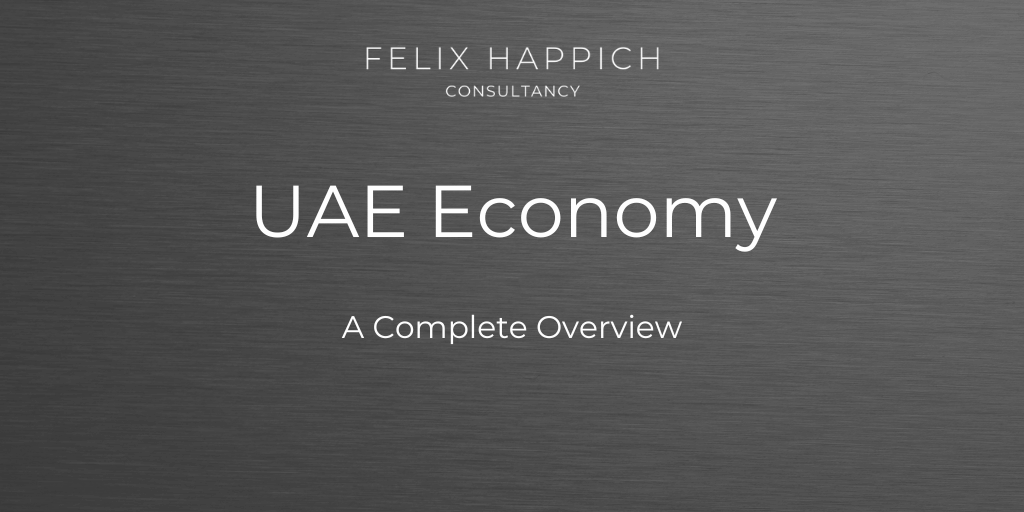The UAE has a diversified and growing economy, which is considered the 4rth largest economy in the Middle East, as stated by IMF reports 2024. It has produced a GDP of AED 1.83 trillion between 2021 and 2023. In past years, the UAE’s economy depended upon oil and gas exports, with 85% in 2009 and 77% in 2011, as per reports of WTO Trade Statista. However, the UAE economy is moving towards the non-oil resources. In 2024, economic sectors like tourism, trade, logistics, financial services, and real estate occupy 70% of the UAE GDP, as reported by the UAE Ministry of Economy.
What are the Fundamental Indicators of the UAE Economy?
The UAE economy is assessed through different fundamental indicators, such as UAE GDP, GDP per Capita, Inflation Rate, Unemployment Rate, Foreign Exchange, Reserves, and Currency. The details of each are provided below.
Gross Domestic Product (GDP)
GDP provides the total monetary worth of all the products and services of a country. In 2024, the GDP of the UAE is $545.1 billion as per reports of the IMF.
| Emirates of UAE | GDP |
| Abu Dhabi | $219.1 billion |
| Dubai | $138.1 billion |
| Sharjah | $56.1 billion |
| Ras Al Khaimah | $14.3 billion |
| Ajman | $10.9 billion |
| Fujairah | $6.8 billion |
| Umm Al Quwain | $0.7 billion |
GDP per Capita
When the total GDP of a country is divided by its population, it gives the value of GDP per Capita. In the case of the UAE, it is $49,560, according to the reports of IMF stats.
Inflation Rate
The inflation rate reflects the changes in the prices of goods and services in a country. In 2023, the inflation rate of the UAE was 1.6%, while it increased to 2.3% in 2024, as per reports of the Central Bank of the UAE.
Unemployment Rate
The unemployment rate of the UAE is constantly decreasing, with 3.36% in 2021, 2.71% in 2023, and 2.17% in 2024, as stated by Macrotrends and CEIC data.
Foreign Exchange Reserves
The foreign exchange reserves include the country’s holdings of foreign currency. The UAE held foreign currency of about AED 818 billion in 2024, as per reports of trading economics.
Currency
UAE Dirham is the official currency which is symbolized by AED. In AED, the letter ‘A’ represents Arab, the letter ‘E’ represents Emirates, and the letter ‘D’ represents Dirham. One UAE dirham or AED is equal to 0.27 USD or 1 US dollar is equal to 3.66 AED.
What is the Rank of UAE’s Economy in the World?
In terms of GDP, the UAE’s economy ranks 28th number, according to the ranking of the World Bank and IMF.
What are the Government Finances and Policies for the Economy of the UAE?
The UAE’s economy is managed by the Ministry of Finance (MOF), which works according to the Federal Decree Law 26. This ministry regulates the budget preparation and management of financial resources. Along with this, the Central Bank maintains a check and balance on monetary policies, prices, and the banking system. Moreover, there are several other economic support schemes, such as the Targeted Economic Support Scheme (TESS), which helps businesses stabilize their operations.
Government Revenue
The General Revenue from all the main sectors resulted in AED 263.9 billion in the first half of 2024. This revenue includes taxes, oil and gas sectors, and non-oil sectors.
Expenditure Patterns
The expenditure patterns of the UAE include expenses of $3.7 billion on fast-moving consumer goods (FMCG), technology, and durable products. The expenses of FMCG are increasing by 6.4% per year, while expenses of technology and durables are increasing by 2.5%.
Trade Balance
The trade balance of the UAE was $39.1 billion in 2023, with exports of $496.5 billion and imports of $457.4 billion, as reported by Country Economy.
Export Revenues
In 2024, the UAE made historical exports of AED 345.1 billion, as stated by Trading Economics, which includes the following:
- Mineral Fuels and Oils resulted in $282.08 billion.
- Pearls, stones, and metals resulted in $90.2 billion.
- Electrical and Electronic equipment produced an export of $42.28 billion.
- Machinery and Nuclear reactors produced $24.37 billion.
Import Expenses
In 2023, the UAE recorded an import of $378 billion, according to the UAE Central Bank Reports.
- The UAE imported pearls, precious stones, metals, and coins for $114.88 billion.
- They imported commodities worth $78.71 billion.
- Electronic equipment worth $63.05 billion was imported.
- They imported nuclear reactors, boilers, and equipment worth $40.84 billion.
Investment Climate
The UAE has invested a significant amount to sustain economic diversification and sustainability. To achieve zero carbon emissions, the UAE government has pledged to invest AED 600 billion, as reported by the Ministry of Finance. Moreover, they have allocated AED 64.1 billion to infrastructure and social welfare as per the report of Business Wire 2024.
What are the Labor Market and Social Indicators of the UAE’s Economy?
The UAE labor market has expatriate workers from diverse backgrounds, such as India, Pakistan, Bangladesh, Nepal, Sri Lanka, America, and the UK. The private job sector is filled with foreigners, while native Emirati covers the public sector. Moreover, the labor participation rate in the UAE labor market is increasing every year; in 1990, it was 76.7%, and in 2023, it increased to 82.6%, according to the CEIC data. At the same time, the UAE labor market is ranked at the top in terms of its employment rate, as per reports of the Ministry of Human Resources and Emiratization (MHRE).
The UAE government has focused on several social indicators, such as literacy rates, life expectancy, infant mortality rate, obesity rates, crime rates, healthcare, education, income inequality, gender equality, and the prevalence of violence. That’s why the UAE is ranked 51st and 2nd in the Middle East, according to reports from Al Etihad Newspaper.
Labor Market
The UAE labor market comprises 7,248,379 workers, according to Trading Economics. In this labor force, female participation is 55.4%, as per reports of the Gender Data Portal.
Unemployment Rate
The unemployment rate in the UAE’s labor market is constantly decreasing every year. According to the data of Macrotrends,
- In 2020, it was 4.29%.
- In 2021, it was 3.11%.
- In 2022, it was 2.87%.
- In 2023, it was 2.71%.
Public Debt
The total public debt of the UAE in 2023 was approximately AED 612,512, as per Statista reports. However, it is decreasing per year; in 2022, it was approximately 30%, and in 2023, it decreased below 30%, according to the reports of Focus Economics and the International Monetary Fund.
Tax Structure
The tax structure of the UAE complies with international standards and diversification of its revenue sources. The UAE’s tax structure is composed of the following components:
- Corporate Tax (CT)
- Value Added Tax (VAT)
- Excise Tax
- Personal Income Tax
- Real Estate Taxes
What are the Monetary and Fiscal Policies for the UAE Economy?
The UAE’s monetary policy ensures stable exchange rates and investor confidence through interest rates, reserve requirements, and liquidity adjustments. Its monetary policy has the following main points:
- The UAE Dirhams have a fixed exchange rate with the US dollars.
- In the banking sector, the UAE regulates credit and liquidity.
- They have designed frameworks for Anti-money laundering (AML).
The UAE has introduced fiscal policies to decrease the government’s dependency on oil resources. Instead, they should focus on infrastructure, foreign investments, and public services. That’s why they have introduced Corporate Tax, Value Added Tax (VAT), public-private partnerships, and diversification strategies.
Monetary Policy
The UAE’s monetary policy is managed by its Central Bank of the UAE(CBUAE). They stabilize the UAE Dirham (AED), which results in economic growth, a decrease in inflation, and an increase in investor confidence. For this purpose, they introduced the Dirham Monetary Framework (DMF) in 2017 and maintained a stable monetary system through liquidity management as per reports of the Central Bank of the UAE.
Banking System
The Central Bank of the UAE (CBUAE) manages local and foreign banks to provide corporate banking, investment solutions, and other Islamic banking products. The main objectives of the banking system are economic growth, financial stability, and innovation.
Economic Diversification
The UAE is continuously trying to diversify its economic sectors to decrease its reliance on oil and gas. In the 1970s, the UAE relied on oil for 80% of its GDP. However, in 2023, 70% of the UAE’s GDP constituted non-oil sectors, such as tourism, real estate, technology, logistics, etc, as stated by the Federal Competitiveness and Statistics Centre.
Fiscal Policies
The UAE government controls government spending and taxation through its fiscal policies. They are diversifying the government funding on infrastructure projects, public sectors, and social programs to reduce their reliance on oil products as per reports of the UAE Ministry of Finance.
The UAE’s International Economic Relations
The UAE is continuously trying to make it one of the top investment hubs and global trade centers by investing in international economic relations. Due to its strong international economic relations, the bilateral trade with China surpassed $99 billion in 2022. In the case of India, the total traded amount was $84 billion. Moreover, the trade with America reached $27 billion in 2022 as reported by the UAE Ministry of Economy and IMF.
What are the Major Economic Agreements of the UAE?
The UAE strengthens its international economic relations through several economic agreements, such as the following:
- The Comprehensive Economic Partnership Agreement (CEPA) was signed between the UAE and India, Indonesia, Israel, and Turkey in 2022, as per reports of the UAE Ministry of Economy.
- The China-UAE Strategic Partnership was also signed in 2022, as per reports of China Daily.
- The Trade and Investment Framework Agreement (TIFA) was signed between the UAE and the USA for bilateral trade in technology, defense, and energy.






